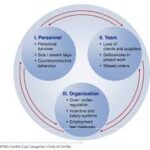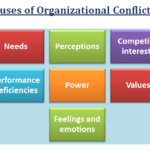In the workplace, conflict resolution conversations are a vital tool for addressing and resolving conflicts early, especially before they escalate into more severe issues. These conversations aim to bring the conflicting parties to a point where cooperation can continue productively. According to Berkel (2005), a well-structured conflict resolution conversation can lead to the de-escalation of a conflict, while Kreyenberg (2005) outlines the process in three key phases: preparation, implementation, and follow-up.
1. Preparation Phase
The preparation phase is essential for setting the stage for a constructive conversation. Before engaging in the discussion, both parties need to manage their emotions (based on the action theory of motivation) to ensure that the conversation remains productive and does not become emotionally charged.
-
Self-reflection: Each party should reflect on their emotions and goals. Understanding what they want to achieve during the conversation, such as resolving the conflict or finding a workable solution, is critical.
-
Strategizing: It’s helpful to think about possible strategies for handling the conversation, how to respond to the other party’s tactics, and where they are willing to make concessions.
-
Setting Boundaries: Participants should be aware of their pain thresholds to ensure they do not overextend themselves in terms of making compromises.
2. Implementation Phase
This phase focuses on the actual conversation where both parties interact to address the conflict. The setting of the conversation is crucial to ensure a positive outcome.
-
Suitable Environment: Choose a quiet and private setting free from distractions, with no time pressure.
-
Opening the Discussion: Start the conversation by creating a welcoming atmosphere, followed by an introductory phase where each party can present their perspective on the conflict. It’s vital that both sides are given an opportunity to express their feelings and viewpoint.
-
Recognizing Common Ground: Identifying areas of agreement or acknowledging mistakes can help ease tension and foster a spirit of cooperation.
-
Joint Problem-Solving: The goal is to find a mutually agreeable solution, resolving both the immediate issue and preventing future conflicts. This may involve addressing both the immediate issue and taking preventive measures, such as changes in processes or behaviors.
Key Points in the Implementation:
-
Ensure the agreement is clear, unambiguous, and aligned with the parties’ core interests.
-
Develop concrete steps for implementation and monitoring the solution.
-
Include sanctions for non-compliance, ensuring accountability.
3. Follow-Up Phase
The follow-up phase is crucial for ensuring that the solution is emotionally accepted and practically applied.
-
Emotional Processing: After reaching an agreement, each party must process the solution emotionally. Resolution of the conflict is not complete until both parties have internalized the solution.
-
Implementation and Monitoring: The agreed-upon solution needs to be implemented, and its effectiveness should be monitored. Regular check-ins can help detect potential issues early, ensuring that the conflict doesn’t resurface.
Role of Human Resources Management in Conflict Resolution
HR professionals can play an essential role in facilitating conflict resolution discussions. Managers may need to address conflicts between their subordinates or even conflicts between themselves and their team. In some cases, a conflict consultant or mediator from HR may be necessary to guide the conversation and ensure a balanced resolution. The HR representative can help keep the conversation on track, provide emotional support, and ensure that all parties’ interests are addressed.
Benefits of Conflict Resolution Conversations
-
Improved Communication: Helps clarify misunderstandings and build better communication between the parties.
-
Restored Cooperation: Resolves conflicts in a way that allows for continued cooperation between colleagues.
-
Reduced Workplace Tension: Prevents future conflicts from escalating, contributing to a more harmonious work environment.






![15 Employee Offboarding Templates That Save Hours of HR Time [Free Downloads] 15 Employee Offboarding Templates That Save Hours of HR Time [Free Downloads]](https://i1.wp.com/www.hrcloud.com/hubfs/Header.png?w=150&resize=150,100&ssl=1)
